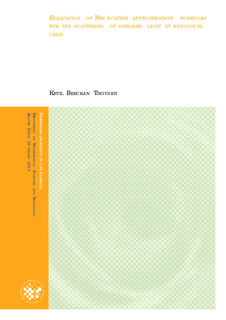| dc.description.abstract | Infrared (IR) spectroscopy has during recent years become a very attrac- tive method for biochemical analysis of cells and tissue, since it can be ap- plied in biological material without destroying its native structure. Since the wavelength of infrared light is comparable to the radius of cells and cell compounds, absorbance spectra are hampered with strong scattering ef- fects, making biochemical interpretation and subsequent data analysis dif- ficult. Since scattering at cells and cell compounds can be approximated by formulas for the scattering of spherical particles, the scatter effects can be approximated by Mie scattering. The exact Mie formula demand ex- tensive computation and make physical interpretations of the scattering effects difficult. In the literature several Mie scattering approximation for- mulas have been discussed. These approximation formulas have different validity ranges for parameters such as wavelength region and scattering angles. The aim of this thesis was to evaluate different approximation formulas for scattering of infrared light at cells and to interpret the basis for these approximation formulas for situations where not only forward scattering is considered. This is highly relevant for FTIR microscopes which have a high numerical aperture.
It is shown that scattering with θ < θNA can be well estimated us- ing the Penndorf, Shifrin and Punina approximation for scattered light at angles θ ∈ [1o,10o] and the Gordon approximation for scattered light at angles θ ∈ [11o, θNA]. An approach which interpolate both approxima- tions is therefore suggested.
Different types of oscillations in the scatter extinction have been inves- tigated and explained in terms of ray dynamics. The exact Mie solution contain resonances as ripples which the approximation formulas do not exhibit. The resonances giving the ripples are explained by ray dynamics where the respective rays enter and leave the sphere in the same direc- tion. Signatures of rays obtained by refraction, can be visualized in the Fourier transform of the extinction curve. For example a triangular ray is expected to appear for refractive indices above m = 2.0 and is determined in the Fourier transform of the extinction. A semiclassical approach, fol- lowing the rules of quantum mechanics, is used to explain rays that cor- respond to bound states in the corresponding quantum mechanical case. Infrarød spektroskopi har gjennom de siste årene blitt en populær metode for biokjemisk analyse av celler og vev, siden det kan bli brukt på biologisk materiale uten å ødelegge dets opprinnelige struktur. Siden bølgelengden på infrarødt lys er i størrelsesorden radius på en celle og dens organeller, vil absorbansspektra bli ødelagt av et sterkt bidrag fra lysspredning, noe som gjør biokjemisk analyse vanskelig. Siden lysspredning i celler og dens organeller kan bli estimert av formler for lysspredning av sfæriske par- tikler, kan lysspredningsbidraget bli estimert som Mie spredning. De ek- sakte Mie løsningene krever stor beregningskapasitet, og gjør tolkning av lysspredningsbidraget vankelig. Mange approksimasjonsformler for Mie spredning har blitt foreslått. Disse har forskjellig gyldighetsområde for parametre som bølgelengdeområde og spredningsvinkel. Formålet med denne oppgaven er å studere forskjellige approksimasjonsformler for spred- ning av infrarødt lys i celler og evaluere grunnlaget for å bruke disse ved forskjellige spredningsvinkler. Dette har betydning for FTIR mikroskopi med objektiver som dekker en stor romvinkel.
Oppgaven viser at spredning ved θ < θNA kan estimeres ved å bruke Penndorf, Shifrin of Puninas approksimasjonsformel for spredt lys med vinkel θ ∈ [1o,10o] og Gordons approximasjonsformel for spredt lys med vinkel θ ∈ [11o,θNA]. En metode som interpolerer disse metodene er derfor foreslått.
Forskjellige typer oscillasjoner i ekstinksjonskurven har blitt under- søkt od forklart ved hjelp av stråledynamikk. Den eksakte Mie løsningen inneholder resonanser i form av skarpe tagger, som approksimasjonsform- lene ikke viser. Resonansene som gir taggene blir forklart ved hjelp av stråledynamikk, der strålene går inn i og ut av den sfæriske partikkelen i samme retning. Ved å Fourier transformere ekstinksjonskurven, kan signaturene fra resonansene som kan oppnås ved hjelp av brytning, visu- aliseres. For eksempel kan en triangulær stråle sees ved brytningsindeks m = 2.0. Denne er funnet i Fourier transformen av ekstinksjonskurven. En semiklassisk fremgangsmåte, som følger lovene til kvantemekanikken, brukes til å forklare stråler som bundene tilstander i det kvantemekaniske tilstanden. | no_NO |
